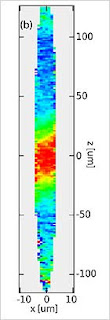Stamper-Kurn's laboratory focuses on studies and applications of BECs, which are gases so cold that all the atoms collapse into the same quantum state, becoming essentially indistinguishable from one another. Stamper-Kurn was a member of the Massachusetts Institute of Technology team that was among the first to create these supercold systems in 1995, a feat for which his advisor, physicist Wolfgang Ketterle, shared the 2001 Nobel Prize.
Though the first condensates were confined by magnetic fields to keep them from touching the walls of a container and heating up, Stamper-Kurn creates his within an "optical trap," essentially a low-power laser beam. He and his colleagues discovered that using an optical trap rather than a magnetic trap enabled the trapped atoms to respond to very minute magnetic fields. This is possible because, in a magnetic field, the spins of the atoms in a cold optical trap precess, just like the axis of a spinning top, at a frequency determined by the strength of the surrounding magnetic field.
A key element in the researchers' magnetometer is a method they developed for taking snapshot images of the orientation of the spin of the ultra-cold trapped gas. By taking a rapid-fire sequence of such snapshots, the team can record a movie of the spin of the atoms precessing, and then calculate the strength of the magnetic field from the rate of this precession. The point of using a BEC for such sensing is that the atoms in this quantum gas hardly move at all. Atoms at different locations can then be counted upon to sense only the magnetic field at their locale.
This feature provides the magnetic sensor with its impressive spatial resolution. Though some hot-gas systems, such as spin-polarized atomic gases, can be used to measure magnetic fields smaller than those measured using ultra-cold gases, their spatial sensitivity is worse because the hot gases diffuse quickly throughout the centimeter-sized devices. The laser-trapped BEC cloud is about one-half millimeter long and 10 microns across - about 10 percent the width of a human hair. One run of the magnetic sensor provides a map of the magnetic field across this entire area simultaneously.
"With the BEC's strengths - its stability, its long coherence times, the fact that collisions don't shift the precession frequency - we have all the ingredients we need for a high spatial resolution magnetometer," said Vengalattore.
"The fact that we can take a single picture showing how all the atomic 'compass needles' have been rotated by the local magnetic field is ideal for getting the precise information we need at once, without having to scan slowly over a surface," added Higbie.
"This finally delivers on the promise of using Bose-Einstein condensed atoms for precision measurement," said Stamper-Kurn.
Vengalattore admits that, for the foreseeable future, the magnetometer will be most useful in probing the magnetic properties of small physical systems like those under study in Stamper-Kurn's laboratory. Currently, the group is using this technique of imaging the spin of the atoms to study quantum phase transitions in a BEC. Just as water undergoes a thermal phase transition when the temperature rises, changing from ice to liquid, quantum systems undergo quantum phase transitions as conditions such as pressure and magnetic field change. The researchers aim to probe such quantum phase transitions using ultra-cold gases confined in a periodic potential called an optical lattice. By studying the magnetic properties of such model systems, they hope to better understand the behavior of more complex magnetic materials. ###
The work also was coauthored by UC Berkeley graduate students Sabrina R. Leslie, Jennie Guzman and Lorraine E. Sadler. The research was funded by the National Science Foundation and the David and Lucile Packard Foundation.
Contact: Robert Sanders rsanders@berkeley.edu 510-643-6998 University of California - Berkeley
Technorati Tags: nanofibers or Nanoscientists and Nano or Nanotechnology and nanoparticles or Nanotech and nanotubes or nanochemistry and nanoscale or nanowires and Bose-Einstein condensate or University of California, Berkeley and quantum fluid or superconducting quantum interference devices and Nanotechnology Today or Public Domain Clip Art and Republican National Convention Blog















No comments:
Post a Comment